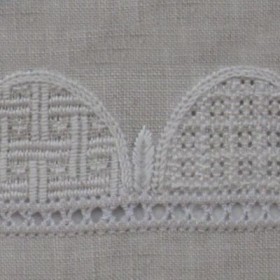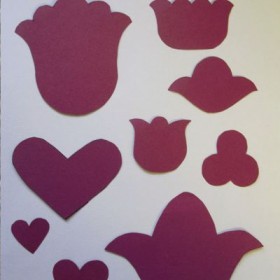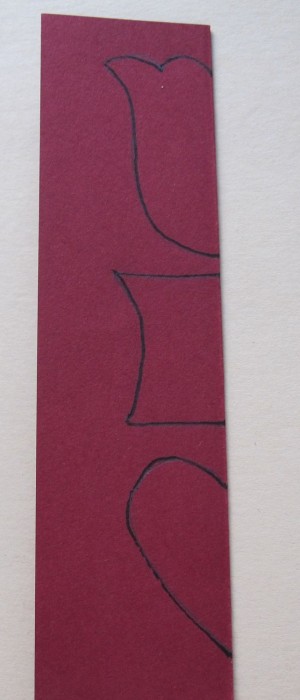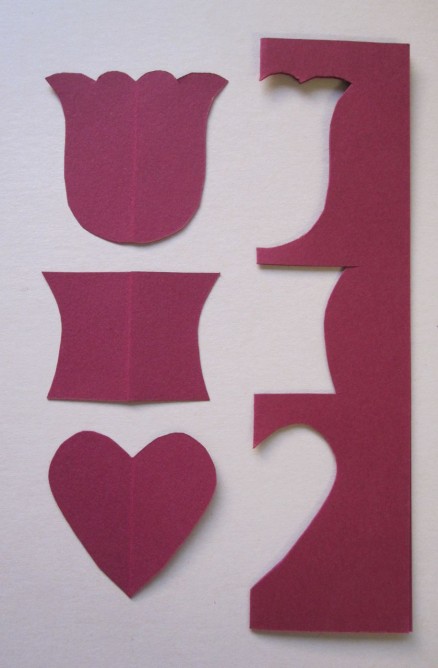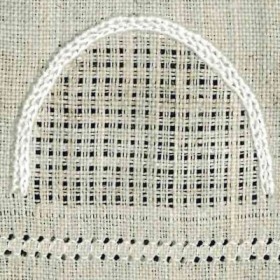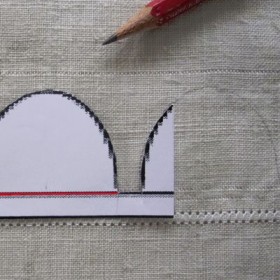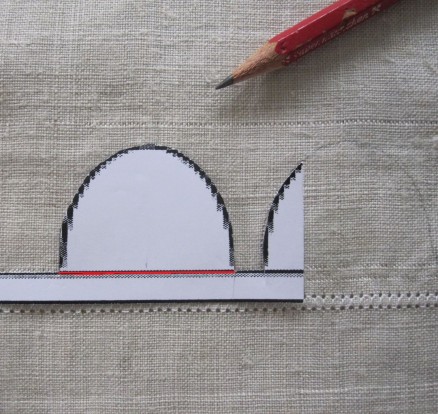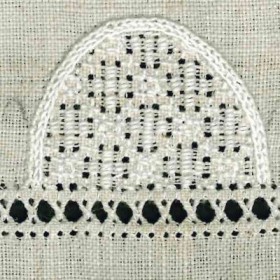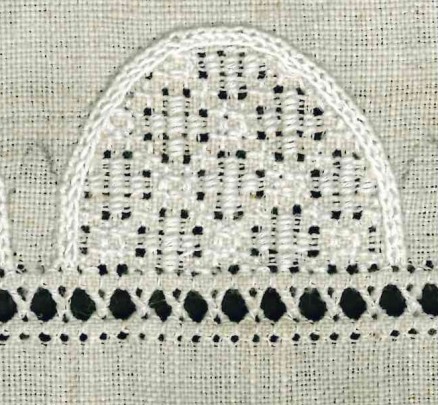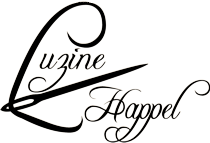After the preparations the filling patterns can now be worked.
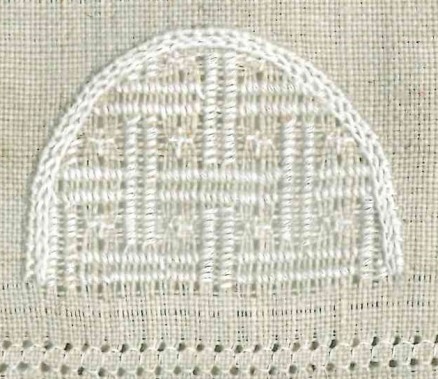
Here I have chosen pattern “447”.
When some of the arch-grids have been embroidered, one can continue the Peahole hem.
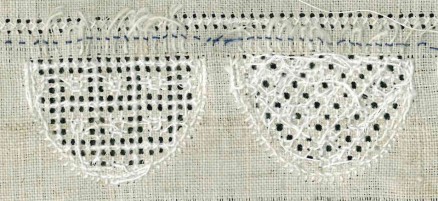
Therefore, withdraw the Running stitches, lay the withdrawn-thread ends to the right – between the two withdrawn-thread lines – and secure them with Four-Sided stitches. The Four-Sided stitches of the first row and those of this row must be perfectly aligned.
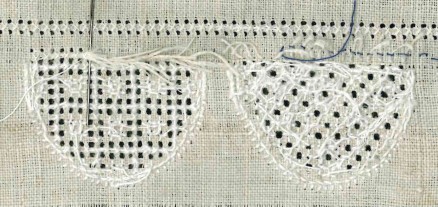
To keep it constant, one must look to the front of the fabric every few stitches to ascertain the two rows of Four-Sided stitches are aligned correctly. This is a little bit tedious. In the end, the secured fabric threads are barely visible.
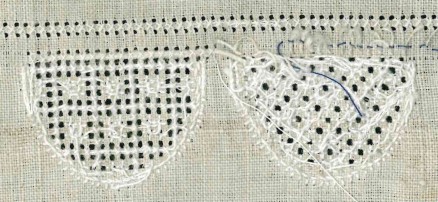
From the front it looks like this:
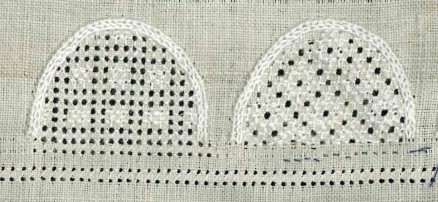
When one has completed a section of 2 parallel Four-Sided stitch rows,
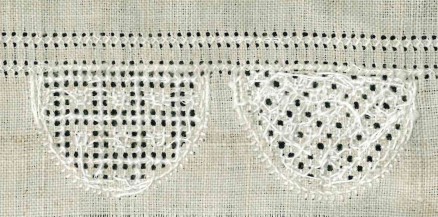
one can withdraw the threads for the Peahole hem
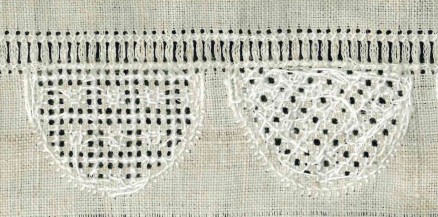
and can work the Peaholes. For exact and very detailed and illustrated step-by-step instructions, please look to my books “Basic Principles of Schwalm Whitework” and “Openwork Pattern Samplers”.
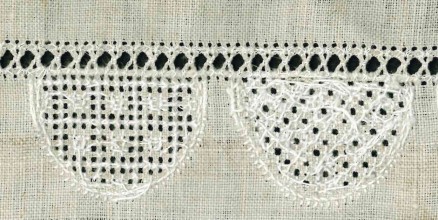
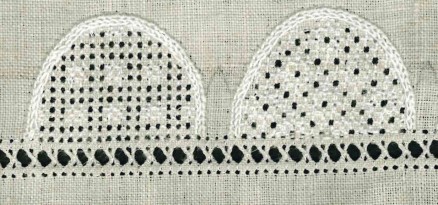
From the front, mark – by hand or using a small stencil – small pointed leaves between the arches and embroider them with densely worked Satin stitches.
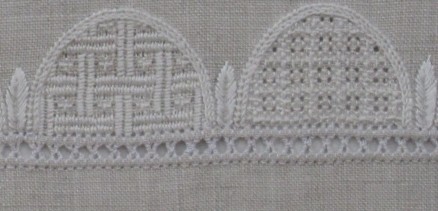
Once the desired number of arches have been worked along one side, the opposite is worked mirrored. The description will be the subject of a later post.
Typical Schwalm designs consist of many different large motifs of simple figures (heart, tulip, basket, circle, etc.) which are bound together by tendrils, small leaves and small flowers.
First, one must create the outlines of the simple figures.
All motifs mirrored on a vertical axis, for example heart and tulip, are created from a fold-cut.
Therefore, a sheet of card stock or paper board is needed. It is folded along its length.
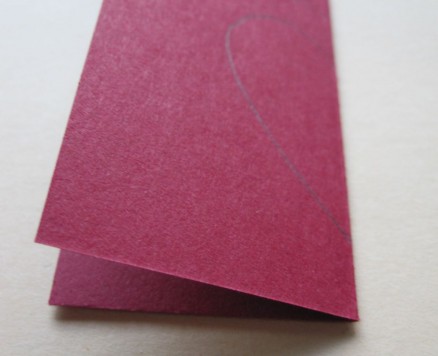
From the fold, half of the desired motif is drawn and then precisely cut out.
In this way one gets stencils in different shapes and sizes.
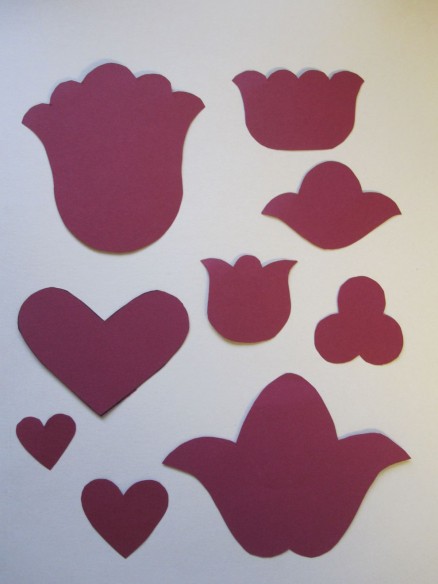 To get circles or segments of circles, a pair of compasses or simple round items may be used.
To get circles or segments of circles, a pair of compasses or simple round items may be used.
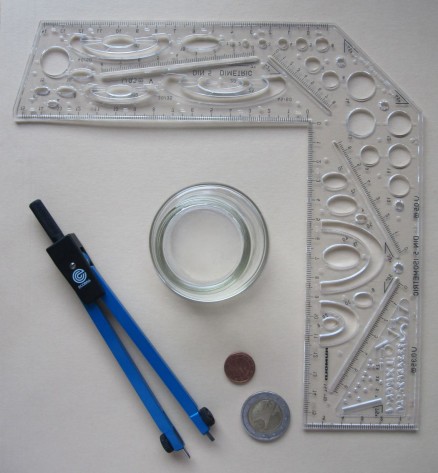
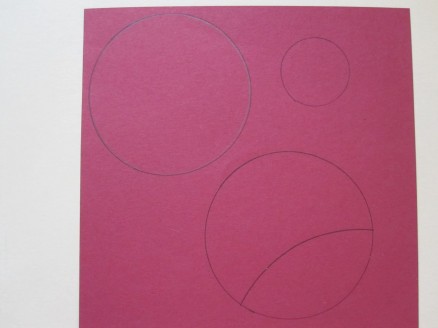 The stencils are laid upon a sheet of paper and held with one hand while the other hand traces around the shape with a pencil.
The stencils are laid upon a sheet of paper and held with one hand while the other hand traces around the shape with a pencil.
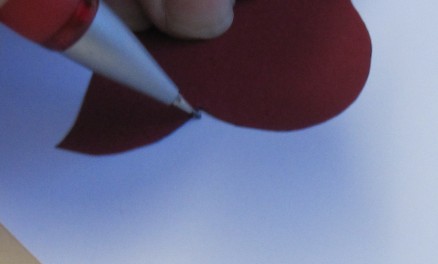
In this way the outline of a motif becomes a part of the design.
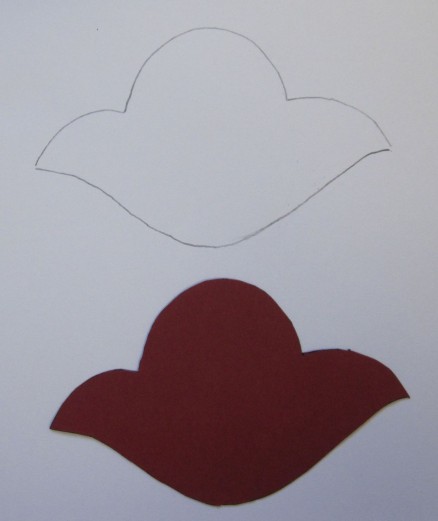
Please try it! It is very fun to get, for example, different tulip shapes using the fold-cut technique.
You will be astonished and surprised by the wide variety of shapes you will get.
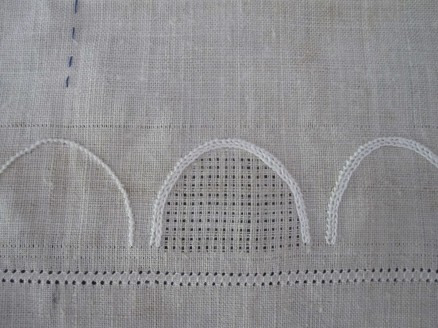 Work Coral Knot stitches along the curved line and, on the inner sider of the Coral Knot stitches, work Chain stitches. Now, working from the back side of the linen, withdraw the threads to establish a grid. In this example, it is a Limet-grid which means to cut 1, leave 3.
Work Coral Knot stitches along the curved line and, on the inner sider of the Coral Knot stitches, work Chain stitches. Now, working from the back side of the linen, withdraw the threads to establish a grid. In this example, it is a Limet-grid which means to cut 1, leave 3.
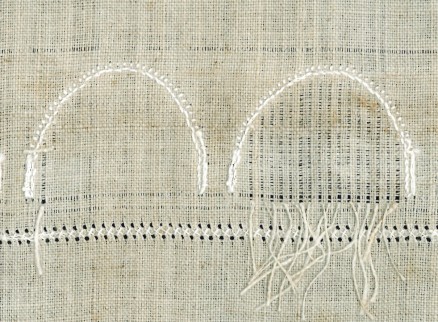 The vertical threads are cut at the curve and withdrawn back to the perpendicular withdrawn-thread line that the arch sits upon. To choose which thread to withdraw, I looked to the Four-Sided stitches.
The vertical threads are cut at the curve and withdrawn back to the perpendicular withdrawn-thread line that the arch sits upon. To choose which thread to withdraw, I looked to the Four-Sided stitches.
Each Four-Sided stitch always consists of a four-thread bundle. To centrally place the Limet-grid, you will want to choose either the left or the right thread of each four-thread bundle.
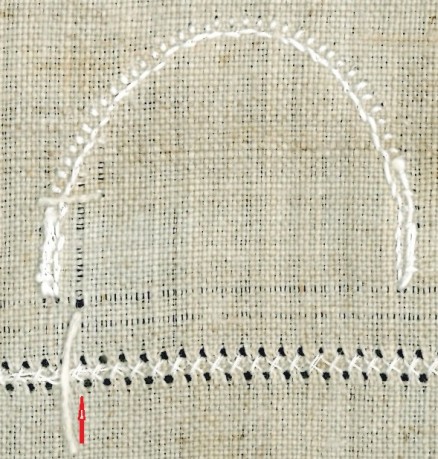 Here I have chosen the right thread of the bundle (see red arrow).
Here I have chosen the right thread of the bundle (see red arrow).
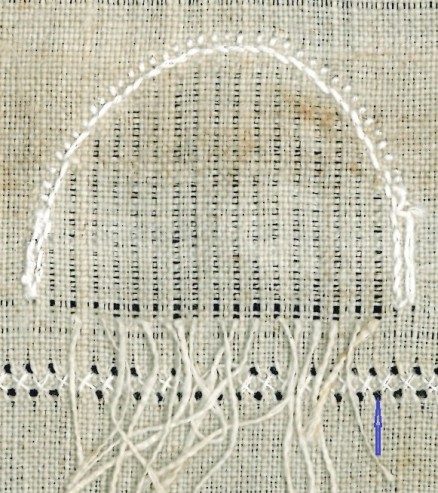 Here I have chosen the left thread of the bundle (see blue arrow).
Here I have chosen the left thread of the bundle (see blue arrow).
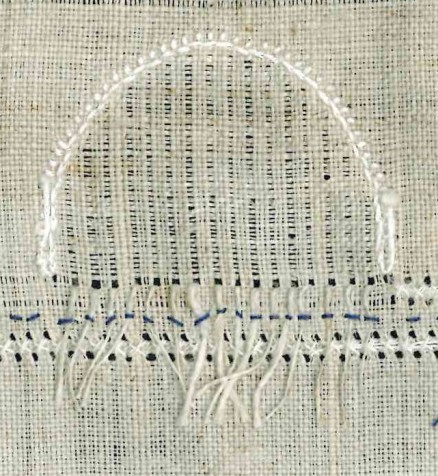 So that the withdrawn threads do not interfere with the embroidery to be done on the grid, lay them away from the grid and baste them in place with short Running stitches using a coloured sewing thread. Trim the ends of the withdrawn threads.
So that the withdrawn threads do not interfere with the embroidery to be done on the grid, lay them away from the grid and baste them in place with short Running stitches using a coloured sewing thread. Trim the ends of the withdrawn threads.
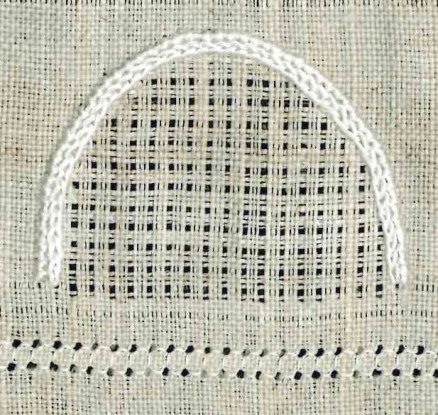 Now, still working from the back side of the fabric, withdraw horizontal threads. Begin from the bottom withdrawn-thread line and leave 3, cut 1 to complete the Limet-grid.
Now, still working from the back side of the fabric, withdraw horizontal threads. Begin from the bottom withdrawn-thread line and leave 3, cut 1 to complete the Limet-grid.
A Limet pattern can now be worked. The longitudinal axis is a thread line. So I chose an appropriate pattern. (It may happen, that the longitudinal axis of an arch is determined by a three-thread bundle.
Then a pattern with a square in the center should be chosen).
Further instructions will be the subject of the next article.
Perhaps you would like to work a table runner or a band with such a border as shown in the article on 1. February 2014. The below picture shows a part of such a band.
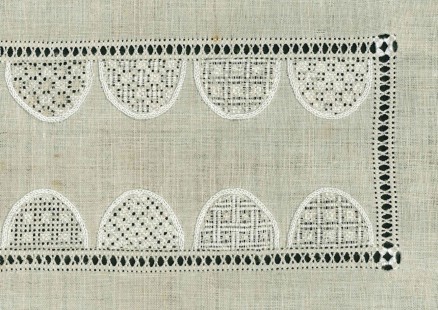
Perhaps you would like to work such a border along the longitudinal sides, and you do not want to set the length of it at the outset (but rather to have the option to adjust the length of your piece according to your enthusiasm). For this situation, please take a piece of linen in the desired width and any length. About 10 cm in from the right narrow edge of the linen, you will begin withdrawing threads. You will withdraw threads along the length of the fabric.
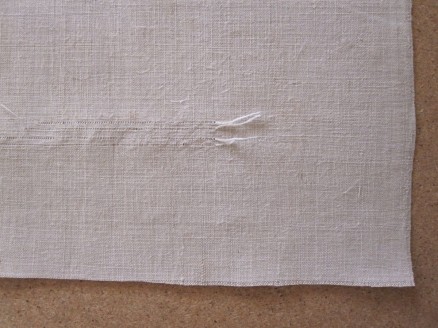
Withdraw one fabric thread (basic line) along the long edge where you want to fasten the hem later.
(In my example the hem should measure 3 cm plus a 1 cm wide fold, so my basic line is 7 cm from the edge. Counting inwards, leave 4 threads, withdraw one, leave 6 threads, withdraw one, leave 4 threads again and withdraw one. The ends of thread remain in the back and will disappear under the hem later.
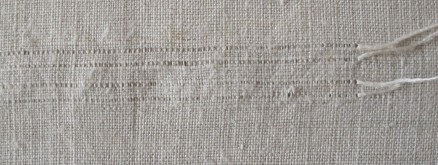
Work Four-Sided stitches over 4 threads between the basic line and the next withdrawn-thread line.
Please keep in mind, if you do not wish to determine your final length beforehand, you will not withdraw threads the entire length of the linen.
Make a stencil of paperboard with a straight edge at the bottom, an arch in the desired size, a space for the narrow leaf, and a section of the arch (this will ensure that the spacing between arches will be consistent). My arch is 3 cm high, 4.3 cm at its widest point, and there is a distance of 0.7 cm between the arches. If the arch were smaller, the pattern could not develop, and if the arch were much larger, it would be unattractive.
Lay the stencil on the ironed fabric so that the bottom line of the arch (red line) sits on the innermost thread line. Holding it in this position, and using a pencil, trace the shape of the arch. Then move the stencil to the left to the point where the partial arch matches up with the just marked line, and trace a second curve. You may choose to mark the desired number of arches all at once, or, if you have not decided on a final length, to mark the arches as you work. When adding arches after embroidery begins, it is important to iron the fabric again, and to keep one arch un-embroidered to be able to accurately place the stencil.
Further instructions will be the subject of the next article.
In Schwalm whitework, hems are not only decorated with Four-Sided Hem stitch, Peahole Hem stitch or Needleweaving; they are also adorned with small decorative borders worked along the seam. The arch border is a very special adornment. There are different versions of arch borders.
Here I will present a very plain one – arches placed side by side, separated by a single narrow leaf.
These arches can be decorated with various filling patterns, and so one can achieve something like a sampler where many different patterns are kept always in sight.
It is very easy to take a half-oval shape, surround it with Coral Knot stitches and Chain stitches (worked on the inner side of the Coral Knot stitches), and to fill the shape with any filling pattern.
However, I decided to connect the arches directly to the Peahole hem.
In this instance, the withdrawn vertical threads are not cut along the edge at the top of Peahole hem, but turned down and caught in the Four-Sided stitches at the top of the Peahole hem.
More detailed instructions will be the subject of future articles.
